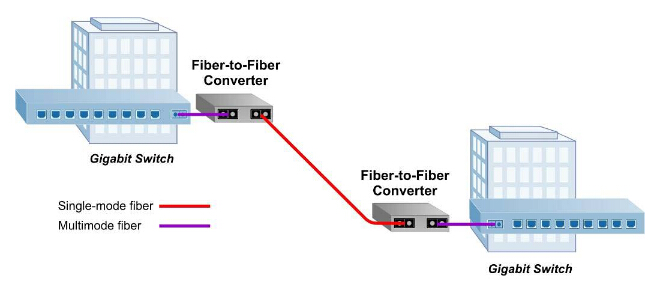It’s common to see in modern society that many enterprise networks must support a wide range of installation environments located indoors and out. Considering this, a wide range of media converters and power supply options are important. And with the great benefits of fiber optic cables being accepted widely, PoE media converter seems to be a better choice for enterprise networks. Today this article intends to explain what PoE media converter can bring for managers and its applications.
PoE media converter is a type of fiber-to-copper media converter. It enables enterprises to power their network devices over the existing copper connections. With its PoE injector, PoE media converters can power devices like IP phones, video conferencing equipment, IP cameras and Wi-Fi devices over copper UTP cabling. Besides, they are available in a variety of multi-port configurations, including dual RJ-45 and dual fiber ports, and they can support fixed fiber connectors or SFP (Small Form Pluggable) transceivers.

Once PoE media converters are connected into network systems, they are usually close to the PDs (Power devices) like IP cameras and wireless access points. And when they work, fiber is run to the power source via the SFP socket, and PoE is distributed over UTP cabling to the power devices via RJ45 port.
PoE media converters bring great benefits for network deployments. For example, they eliminate the need for power supply devices, power cables and outlets that would be required for remote device. In addition, they also provide flexible network design options. Here are some examples.
As shown in the following picture, single fiber ports are deployed in star topologies with a point-to-point style layout with the fiber switch in the center of the network.

Option 1: daisy chain design. This design uses dual fiber ports to support connections in a liner daisy chain configuration. It suits long-haul applications along subways and rail lines.

Option 2: fiber ring design. In this fiber ring architecture, traffic can flow in both directions. In the picture below, a switch connects three PoE media converters to form a ring. If a fiber failure occurs in it, the switch can reroute the traffic in the opposite direction.

Option 3: redundant fiber design. This network structure uses two fiber connections. One is active and carries the data traffic. The other is a protection fiber port that back-up a fiber failure switch-over of less than 50 milliseconds.

As we all know, in order to break out the distance and bandwidth limitations of copper cables, fiber optic cable is a good alternative. PoE media converters can convert copper to fiber and provide power at the same time, making it popular among enterprise networks. There are three main applications of PoE media converters.
- Fiber to IP cameras. The PoE media converters have fiber uplink ports and downlink ports. And in most applications, two IP cameras at each location can be connected through the dual RJ-45 ports of a PoE media converter.
- Fiber to wireless access points. PoE media converters enable wireless access points to be installed in office buildings, airport, hotels, public areas or other places needed.
- Fiber to the desktop. The PoE media converters provide fiber to copper media conversion, and they send data and power to desktop items such as IP phones and video conferencing equipment.
PoE media converters provide a cost-effective way to extend distances over fiber optic cabling to PoE powered devices (PDs). In this article, four network designs with PoE media converters and three applications of them are illustrated simply. If you want to know more details about PoE media converters, please visit FS.COM.
Related article: Things You Need to Know About Power Over Ethernet (PoE)
Related article: How Much Do You Know About PoE?


